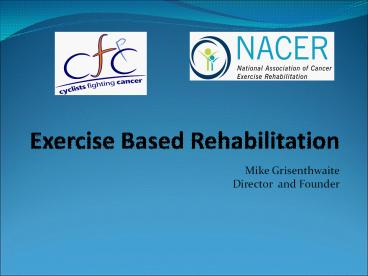Exercise%20Based%20Rehabilitation - PowerPoint PPT Presentation
Title: Exercise%20Based%20Rehabilitation
1
Exercise Based Rehabilitation
- Mike Grisenthwaite
- Director and Founder
2
About me..
- Diagnosed 2000 Lymphatic Cancer NHL
- Ironman Triathlon 2001
- Numerous other endurance events
- Relapse 2005
- Donor stem cell transplant or BMT.
- 2007 Tour de France 2200 miles in 19 days
- Personal Trainer and Certified Cancer Exercise
Specialist Northern Colorado University
3
Overall Cancer Risk
- Involvement in occupational or leisure-time
activity or being physically fit is associated
with a reduced risk of cancer - Typical risk reduction of 20-30
- Independent of other lifestyle
- factors
- Risk reduction is dose-related
4
Physical Activity and Cancer PreventionPossible
Mechanisms
- Sex steroid hormones oestrogen, testosterone
- Energy balance fat distribution
- Growth factors Insulin/ IGF-1/IGF-BP3
- Anti-inflammatory system C reactive Protein,
interleukins - Immune defence system NK cells
- Antioxidant defence system/DNA damage/ apoptosis
5
Cancer SurvivorshipCancer Statistics - 2002
- Cancer incidence
- One in three people in UK will develop some form
of cancer in their lifetime. - Cancer survival rates have increased
- 43 of men and 54 of women survived to five
years after diagnosis (prostate has improved to
60 and breast to 77) - Number of survivors
- 2 of men and 2.7 of women in Scotland are
living with cancer (1.2 of women in Scotland are
living with breast cancer).
6
Exercise and Activity for Children and TYAs -
Evidence
- The few childhood studies are far more neutral.
- Restricted by numbers of participants
- Access to facilities
- Measurement comparisons - age
- Activity motivation
7
Research evidenceBeneficial effects of exercise
interventions
Exercise during treatment
Exercise after treatment
Functional capacity Body weight
composition Fatigue Nausea Flexibility Physical
well-being Satisfaction with life Quality of life
Exercise capacity Natural killer (NK) cell
activity Mood Self-esteem Lean body mass body
fat Decreased levels of depression
anxiety Quality of life No adverse effect on
Lymphoedema
8
Exercise After Diagnosis Association with
Recurrence Mortality Data from Cohort of
2987 Breast Cancer Survivors in Nurses Health
Study
Relative Risk
Level of Exercise (MET hrs/week)
Holmes et al. JCO 202479-86, 2005
9
The Rehabilitation Exercise for Health After
Breast Cancer (REHAB) Trial
- RCT comparing aerobic
- exercise to control in 53
- postmenopausal BC
- survivors post therapy.
- Primary endpoints were
- QOL, fitness, biomarkers.
10
Baseline (p.807) Change (plt.001) 3.3 (18)
(Courneya et al. JCO 2003211660-8)
11
Baseline (p.286) Change (p.001) 8.8 (3.6 to
14.0)
(Courneya et al. JCO 2003211660-8)
12
Baseline (p.518) Change (p.017) -0.006 (-0.01
to -0.001)
(Fairey et al. CEBP 200312721-7)
13
Baseline (p.307) Change (plt.001) 6.0 (2.8 to
9.1)
(Fairey et al., submitted)
14
Activity Levels for Patients and Survivors What
is recommended?
- 30 minutes
- 5 days a week
- To a moderate intensity i.e.
- 60 70 of Maximum Heart
- Can be accumulative.
- This applies to everyone here!
- VERY IMPORTANT Practical note
- Carers need to buy in to this
15
Nacer Wish list
- To get exercise based rehabilitation results into
practice via - Integrating physical activity with other
supportive care interventions - Physiotherapy.
- Psychosocial interventions.
- Complementary Therapies etc.
- Training of primary, secondary and tertiary
health professionals and community based exercise
instructors. - Provision of information through various existing
media channels
16
Future Projects - Nacer
- Participation in TYA Cancer Survivorship
programme at the Christie Hospital. - More user friendly Website Focused on Patients
and Support Networks - Supplying information on
- local initiatives
- Cancer Exercise Specialists
- One to one consultation
- Latest proven research, downloads etc.
17
Cyclists Fighting Cancer
- in 2CFC award new bikes, tandems and specially
adapted trikes to children and young people who
have been affected by cancer throughout the UK
and Northern Ireland. - We encourage cycling as the best form of exercise
based rehabilitation for those children
undergoing and recovering from cancer treatments.
- To encourage them further CFC also give bikes to
their siblings and in many cases their parents in
order that they can take part in an activity as a
family once again after what can be years of
hospitalisation and disruption. - Awarded over 300 bikes so far.
18
Bike Awards
- Referrals via Clic Sargent and other social
workers, Physios, Consultants, Support groups
etc. - 0-18 years
- Siblings Included
- Can include parents
- No Cost whatsoever
- UK and Northern Ireland
19
The Benefits
- Moment of delight
- Assists mobility
- Gives back choice
- Family Activity
- Reintegration/normality
- Reconditioning of Muscles
- Help with side affects of treatment
20
Future Projects - CFC
- Pilot Scheme at the John Radcliffe Hospital
Oxford. - CFC has provided 2 static exercise bikes in
junior and Adult size. 5 2 upwards - Currently undergoing evaluation by physios on
site. - We hope to identify 2 further hospitals in 2009.
21
Get Set, Ready, Go!
- Contact details
- email mike_at_cyclistsfc.org.uk
- Web
- www.cyclistsfc.org.uk
- www.nacer.org.uk
- Thank you.






























